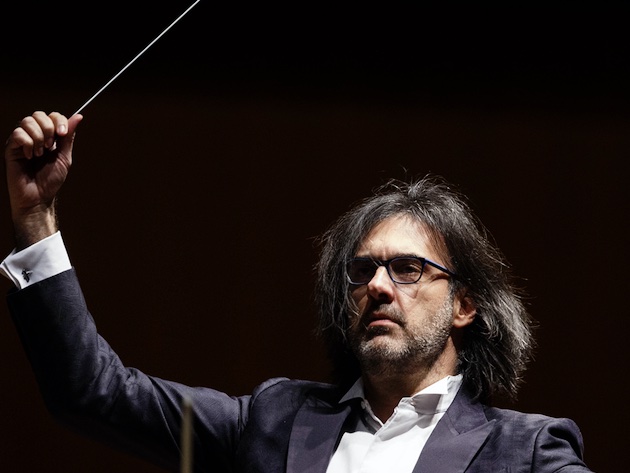Kavakos displays impressive bivalved talents with New World Symphony

Violinist-conductor Leonidas Kavakos performed Mozart and Brahms with the New World Symphony Saturday night.
Leonidas Kavakos has had an impressive week in South Florida. The Greek violinist gave a masterful account of Brahms’ Violin Concerto with the Palm Beach Symphony on Tuesday night. On Saturday, Kavakos took the stage of the New World Center as both soloist and conductor with the New World Symphony and scored in both capacities.
Mozart’s Violin Concerto No. 4 in D Major is the most virtuosic of the Salzburg genius’ five concertos for the instrument. With his nearly flawless technique, Kavakos was in total command of the score’s challenges. Utilizing spare vibrato in both his solo playing and that of the chamber orchestra, he delivered a performance that was influenced by the period instrument movement with crisp tempos and learn textures.
Yet, in many ways, Kavakos’ Mozart was old school—stylish and aristocratic but without any hint of stodginess. He sailed through the first movement with verve. The Andante cantabile, an operatic aria for the violin, emerged with transcendent beauty under Kavakos’ fingers, with a light touch. Kavakos dispatched the Rondo finale with ample vivacity, his bow bouncing on the strings. In the central episode, Kavakos shaped the melodic lines with the stateliness of a minuet.
The orchestral playing was consistently well balanced and agile. Kavakos was enthusiastically received by both the audience and players, applauding and tapping their bows.
The track record of violinists who have tried their hand at the podium is mixed at best. Kavakos appears to be one of the more successful leaders. Brahms’ Symphony No. 4 in D minor is the most difficult of the composer’s four essays in the symphonic genre for conductors to bring off. Some outstanding conductors have failed when attempting the work.
Conducting sans baton and score, Kavakos got all the big details right, delivering a performance both energetic and eloquent. From the outset, he brought out the unique Brahms sonority, dark and mellow. This season’s New World fellows have played consistently well regardless of who was on the podium, and they displayed stellar ensemble under Kavakos. Exhibiting fine balancing and dynamic control, he avoided the brass overpowering other choirs in the climaxes.
Kavakos adroitly phrased the initial wind melody of the Andante moderato in expansive lyrical paragraphs and lavished a long- limbed sense of line in the secondary motif, one of Brahms’ most memorable inspirations.
The dance-like theme of the tAllegro giocoso resounded in robust fashion. The crucial horn parts were conveyed with steadiness and accuracy and textures were so transparent that even the triangle part proved audible.
The concluding passacaglia is a minefield for both conductor and orchestra but the crisp thrust of Kavakos’ conception held the movement together. Crucial wind lines were bright and tonally glowing, with the solo flute a standout. Each of the variations on the principal theme (which Brahms derived from a Bach cantata) was given individual spirit and character. Kavakos consistently kept the larger structural picture front and center, maintaining taut control over the movement’s expanse. While one performance does not tell the story of any conductors’ skills, one definitely wants to hear more of Kavakos’ work on the podium. He certainly knows his Brahms.
Now in her second season as the New World’s conducting fellow, Molly Turner has displayed versatility in a wide variety of music, both familiar and rarely played. She offered a propulsive reading of the Overture No. 1 in E minor by Louise Farrenc (1804-1875).
Recent seasons have seen a welcome resurgence of performances of works by female composers, past and present. Farrenc was a contemporary of Mendelssohn and Schumann and her music bears a stylistic similarity to both. Farrenc was an inspired melodist and her seven-minute opener sings in lively and engaging fashion.(Farrenc’s three symphonies are also worthy works deserving of revival.) Turner led a brisk traversal that kept the sparkle of Farrenc’s orchestration and tuneful writing to the fore.
The New World Symphony repeats the program 2 p.m. Sunday at the New World Center in Miami Beach.
The New World Symphony’s final chamber music program of the year features Melody Eōtvōs’ The King in Yellow and Mozart’s Quartet in E-flat Major for piano and winds and Messiaen’s Quartet for the End of Time with pianist Anne-Marie McDermott. 2 p.m. December 22. nws.edu
Posted in Performances
Leave a Comment
Sun Dec 15, 2024
at 12:30 pm
No Comments